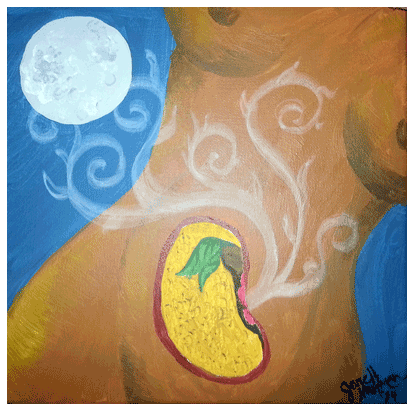The dancing ebb and flow of nature–it’s around us and within us. Ancient peoples from countless traditions have taught us that forging a personal relationship with these rhythms is central to balance in body, mind and spirit. We can experience these rhythms reflected in the symphonic coordination of the endocrine system– our hormonal network. The word hormone itself comes from the Greek: hormon “That which sets in motion.”
(painting by Janell Hartman, RYT)
Seed cycling is a natural way of helping us to balance hormone levels by strategically incorporating varying seeds and oils into our diet during the two major phases of the menstrual cycle. Excess hormones can be processed and eliminated, and deficient hormones can be increased in measure due to their specific endocrine-stimulating properties. This method may offer the benefit of tuning our natural rhythm to the moon, balancing irregularities, reversing absence (amenorrhea), and soothing harsh cramping and PMS symptoms.
How it works
Phase 1: Follicular Phase (Days 1 through 14)
Day 1 starts on the first day of bleeding. If your cycle is absent, begin on the new moon.
The goal during this phase is to regulate estrogen production and absorption. Estrogen prepares the body for ovulation. Too little can inhibit this crucial function. Too much can aggravate the uncomfortable symptoms that are all too common with menses.
The high omega-3 fatty acid consumption in this phase (in balanced ratio to omega 6 fatty acids) promotes healthy cell membranes, allowing hormones to reach their destinations within the body.
-Consume 1tbsp each of soaked and ground flax seeds and pumpkin seeds daily
-Take a high quality fish oil supplement to get 1500-2000 mg of EPA/DHA daily
Flax seeds contain high levels of lignans. Bacteria in the gut convert lignans into enterolactone which blocks estrogen receptors, so the body is cued to halt the production of extra estrogen.
Pumpkin seeds are high in omega 6 fatty acids and exceptionally high in zinc, which is important for reproductive functions, protein absorption and the immune system.
*Please note: If you have trouble with low estrogen levels, flax seeds should be very lightly consumed during this phase or omitted. Schedule a consultation with one of our naturopathic doctors to have your estrogen levels tested.
Phase 2: Luteal Phase (Days 15 through 28)
Ovulation marks the beginning of this phase.
The goal is to raise progesterone levels. The dominance of Omega 6 fatty acids within the seeds and oils of this phase naturally stimulate its production. Progesterone’s main task is to control the build up of the uterine lining and sustain it if there is a pregnancy. If there is no pregnancy, then progesterone levels fall and the lining of the uterus is shed thus beginning the menstrual cycle (looping back to Phase 1). It’s known as “the relaxer” as it assists with taking the edge off smooth muscle contractions…in other words, it helps reduce unpleasant cramping sensations.
-Consume at least 1 tbsp each soaked and ground sunflower seeds and sesame seeds daily
– Take 1500-2000 mg Evening Primrose oil daily
Sunflower seeds are a rich source of omega 6’s and contain very high vitamin E, one of the fat-soluble vitamins that supports reproductive functions. They are also high in selenium, a trace mineral that helps with liver detoxification. Liver toxicity and depletion has been linked to excess cramping and menstrual irregularity.
Sesame seeds are a fitting partner-seed for this phase in that they greatly increase the bioavailability of the vitamin E in the Sunflower seeds. Like flax, sesame seeds contain high levels of lignans.
*Please note: Both the sunflower and sesame seeds are high in copper. In some individuals whose zinc levels are very low this can cause an increase in the severity of premenstrual symptoms. Copper is an antagonist to zinc, which means as copper levels rise, zinc levels will drop. If your zinc levels are low, consider omitting the sesame seeds and using only the sunflower seeds and evening primrose oil during Phase 2. Also consider slightly increasing pumpkin seed consumption during Phase 1. Schedule a consultation with one of our NDs to test zinc levels if you suspect they’re low.
Why Soaking Your Seeds is Crucial:
Seeds (nuts and whole grains too) are coated with phytic acid, tannins and goitrogens—all natural enzyme inhibitors, which allows them to survive until proper growing conditions are present. Soaking and/or sprouting sends a signal to the seed/nut/grain that it’s time to let down their chemical guard.
If these foods are consumed regularly without being soaked or roasted, the inhibitors can severely strain and disrupt the digestive process. At worst, this can lead to mineral depletion, bone loss and problems with colon congestion and bile flow. For seed cycling, we need the natural magic of these seeds to be bioavailable, so don’t skip the soaking process. The effort is small in ratio to the payoff.
Soaking made easy
Soak your seeds in clean water with a squeeze of lemon juice or tsp of apple cider vinegar for at least 7 hours/overnight. Use a strainer to rinse when they’re done, dehydrate (no higher than 115 degrees) or store in fridge for a few days. Lightly roasting can decrease enzyme inhibitors but will diminish the healing properties, somewhat. However, it’s much better than eating them raw.
Eating made easy (and yummy)
Using food as medicine requires some clever integration. It can seem like a lot to remember and manage at first. It takes some patience to find a routine and settle in. Then, like anything else, it can be done easily.
For example…
Tahini is an easy way to get your sesame seeds. If it ever makes it off the spoon, it pairs with just about every kind of food you can think of.
The rest can be added to salads and soups, or made into crackers. Crackers are convenient are a conveniently measured dosage of the Phase seeds, great on-the-go and super delicious.
These are simple cracker recipes I use for Phase 1 and Phase 2:
Follicular (Phase 1) Raw Crackers
Ingredients:
1 cups of raw soaked pumpkin seeds
1 cup of soaked flax seeds
1 tbsp of raw apple cider vinegar or lemon juice
2 tsp sea or Himalayan salt
Spices to taste, be creative (I like rosemary, garlic and black pepper)
Enough liquid to blend in Vitamix or food processor (pure water or veggie juice)
Luteal (Phase 2) Raw Crackers
Ingredients:
1 cup of raw soaked sesame seeds
1 cup of raw soaked sunflower seeds
3 tbsp chia seeds to bind
1 tbsp of raw apple cider vinegar or lemon juice
2 tsp sea or Himalayan salt
Spices to taste, whatever you like (I like black pepper, garlic and curry)
Enough liquid to blend in Vitamix or food processor (pure water or veggie juice)
Directions for both Follicular and Luteal Phase Crackers
Combine all, blend or process until seeds are pulverized, spread ¼ inch thick on dehydrator trays (use non-toxic parchment paper if you don’t have the fancy non-stick dehydrator sheets) and dehydrate below 115 degrees if possible. Halfway through, use a knife to score them and then keep drying until chewy or crispy, your preference. Parchment paper-covered cookie sheets in an oven on its lowest setting with door cracked open slightly can serve as a dehydrator in a pinch.
What to Expect
This process will take a few months to move into full swing. The cycle/symptoms didn’t go out of balance overnight, and will probably not return in that timeframe. Knowing the properties of the individual seeds and oils and tuning into your body’s particular needs will allow you to adjust the process as needed.
Seed cycling is not the best solution if your menstrual flow is already extremely heavy, since seed cycling stimulates this aspect and can create further imbalance. If your gall-bladder has been removed or functions poorly, it’s wise to be careful with adding significant amounts of fat to your diet. It is still possible to use seed cycling, but it will need to be accompanied by specific enzymatic supplementation. Please consult with a naturopathic doctor before moving forward.
In my personal experience with seed-cycling, the very first month I felt the benefits of mood regulation, general relief of inflammation, reduced food cravings (particularly sugar), and much less cramping. The full fruit of the practice came three months in. I am now regular with the new moon and a healthy flow (mine was deficient and/or missing for years), nearly cramp-free, calm and centered psychologically before and during my cycle and no longer experience any significant water retention, skin break-outs or breast soreness.
When my luteal phase (flow) begins, I give myself permission to take a time-out from my busy schedule. Not for the previous reasons of feeling exhausted, crampy and crazy, but to nurture myself–steeped in gratitude for my womanhood and the sacred reflection of the grand cycle within. We belong to the Earth, and like the ideal Mother, she guides us towards our highest potential when we heed her timeless prescriptions.

Janell Hartman, RYT

